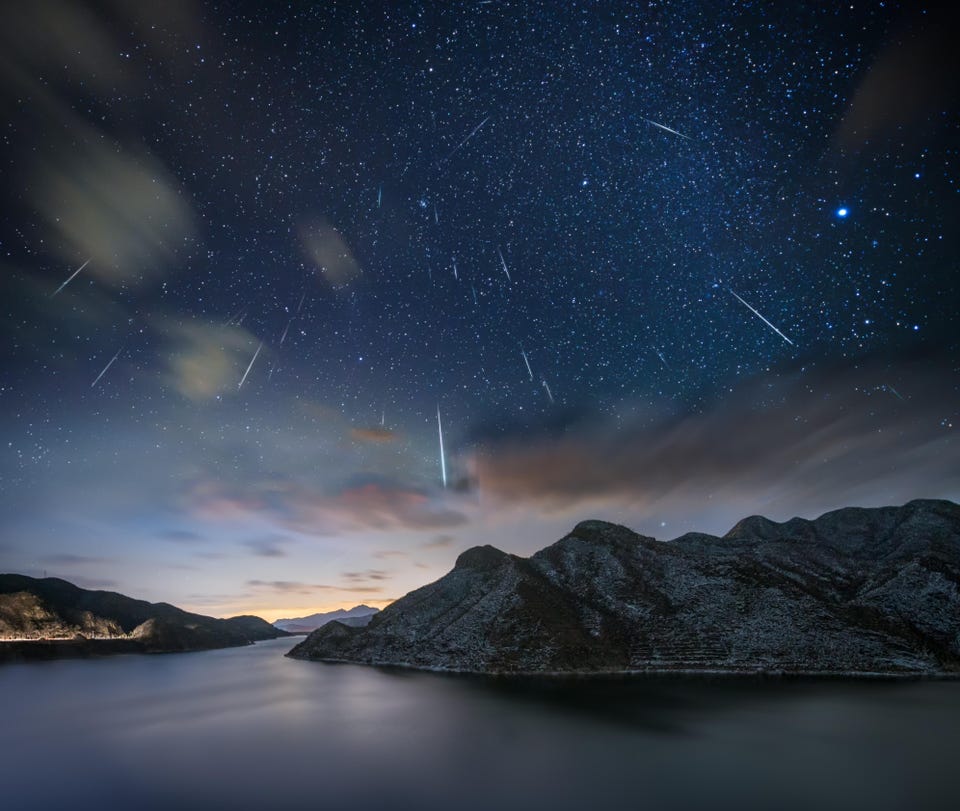Science ‘Shooting Star Saturday’ Will See Three Meteor Showers, Two Asteroids Whizz By And A 25-Ton Chinese Rocket Re-enter Jamie Carter Senior Contributor Opinions expressed by Forbes Contributors are their own. I inspire people to go stargazing, watch the Moon, enjoy the night sky New! Follow this author to improve your content experience. Got it! Jul 30, 2022, 04:51am EDT | New! Click on the conversation bubble to join the conversation Got it! Share to Facebook Share to Twitter Share to Linkedin Are you ready for “shooting star Saturday?” Getty Get your eyes to the night skies this weekend and you may see about 20 “shooting stars” from three streams of meteors caused by our planet surging through the leftovers of three separate comets.
The key time for that is Saturday evening—just before midnight through until two hours before sunrise. However, there are a few other objects buzzing around Earth this weekend including two massive asteroids and, yes, some falling rocket debris. Here’s what you need to know: Three meteor showers will combine Expect about 20 “shooting stars” per hour on Saturday night through Sunday morning as the peaks of the Delta-Aquarid and (less prolific) alpha Capricornid meteor showers combine under dark moonless skies.
The Delta Aquarid meteor shower is caused by dust and debris being left in the inner Solar System by Comet 96P/Machholz while the alpha Capricornids come from comet 169P/NEAT. There will also be “shooting stars” around from the Perseid meteor shower, usually the year’s most popular display. They’re caused by Comet Swift-Tuttle.
However, the peak of the Perseids meteor shower this year takes place on the night of the full Moon, which will make it very difficult to see all but the brightest meteors. MORE FOR YOU New Research Finds A Connection Between Domestic Violence And These Two Personality Disorders This Scientist Helps Andean Forests And Ecuador’s Women In STEM Exceptional Fossil Preservation Suggests That Discovering Dinosaur DNA May Not Be Impossible So for this year it’s best to avoid the peak night of the Perseids meteor shower and instead look up this weekend for the peak of the Delta Aquarids—and some extra “shooting stars” from both the waxing Perseids and the alpha Capricornids. Two asteroids will pass close to Earth Early on Saturday a 400 feet-wide asteroid called 2016 CZ31 will buzz past Earth at a distance of about 3 million miles/2 million kilometers at 1:00 UTC (7 p.
m. EST on Friday). Later on Saturday at around 7:37 p.
m. ET the 2013 CU83 asteroid—which is about 600 feet in diameter—will swing through the Earth-Moon system, though at its closest it will get to only 4,320,000 miles/6,960,000 kilometers. That’s far beyond the Moon.
A Long March 5B rocket lifts off from the Wenchang launch site on China’s southern Hainan island on . . .
[+] May 5, 2020. – Chinese state media reported the “successful” launch of a new rocket on May 5, a major test of its ambitions to operate a permanent space station and send astronauts to the Moon. (Photo by STR / AFP) / China OUT (Photo by STR/AFP via Getty Images) AFP via Getty Images A Chinese rocket will fall to Earth Did you hear about China’s new Tiangong space station? The second “Wentian” module of its was launched from the Wenchang Space Launch Site, China on July 24, 2022 on a Chinese Long March 5B rocket.
However, that rocket core will return to Earth Saturday—and it’s not clear exactly where it will land. The Aerospace Corporation’s Center for Orbital and Reentry Debris Studies predict that it will re-enter Earth’s atmosphere at 18:16 UTC plus or minus five hours. Its weighs 25-tons (23 metric tons) rocket stage, which launched on July 24 to deliver the Wentian laboratory cabin module to China’s incomplete Tiangong space station, is predicted to reenter Earth’s atmosphere on July 30 at 7:24 p.
m. ET, give or take 16 hours, according to researchers at The Aerospace Corporation’s Center for Orbital and Reentry Debris Studies . However, it’s too early to tell where it will land.
Updates here: Wishing you clear skies and wide eyes. Follow me on Twitter or LinkedIn . Check out my website or some of my other work here .
Jamie Carter Editorial Standards Print Reprints & Permissions.
From: forbes
URL: https://www.forbes.com/sites/jamiecartereurope/2022/07/30/shooting-star-saturday-will-see-three-meteor-showers-two-asteroids-pass-safely-and-a-25-ton-chinese-rocket-re-enter/
